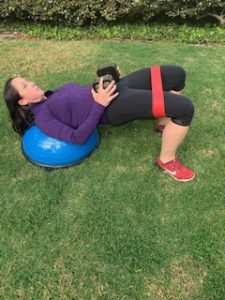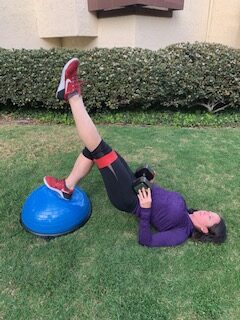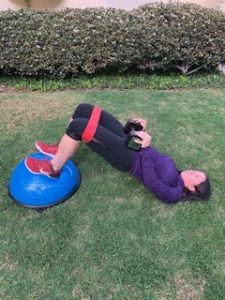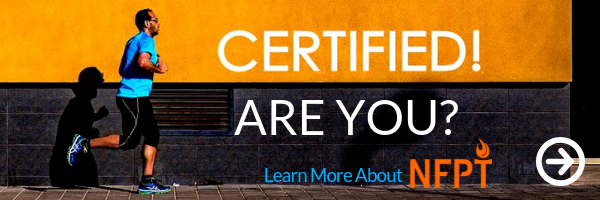Last month glute bridges were a hot topic of conversation because of their versatility in serving a wide range of clients and client needs. This progressive exercise is great for both those who are working with limitations or injuries as well as those who are looking to strengthen their core and glutes. This month I thought it would be fun to introduce some creative ways to progress this simple move to generate greater mobility and strength. Below is a list of five bridge progressions for clients looking to turn up the heat on their basic glute bridge routine.
Glute bridge with a mini-band
A simple build on the glute bridge is the addition a mini-band around the base of the client’s calves or above his or her knees.
- Establish bridge position with knees bent, feet and upper body (hips to head) on the floor.
- Equally distribute weight in the feet and drive the hips up until softly on the shoulders without cervical spinal compression.
Some clients find they are able to correct any knee caving (valgus shifting) they experience by adding the band and putting the focus on keeping it taught.
Bonus: To add a little more challenge, clients can isometrically hold the bridge at the top and do a 2” pulse of the knees pressing out against the band.
Single-Leg Glute Bridges
This is a bit more of a challenging progression on the standard glute bridge variation where one leg supports the
movement, while the other leg is extended in the air, and incidentally fires up the glute fibers twice as much as the two-legged variety.
- Start with two feet on the ground with knees at a 90-degree angle (slightly ahead of knees) and lift hips.
- Once at the top of the bridge, extend one leg and continue the lower and lift pattern on the supporting leg.
Beginning with both feet on the floor prevents the tendency of attempting to shift one foot to the center of the body and thus fires up the core, stabilizing, and anti-rotational muscle groups. The change in knee angle helps to recruit the glutes more fully.
Bonus: Try a 2” pulsing up and down of the working leg.
Glute Bridge with a Dumbbell
Yet another way to progress the glute bridge is by loading the body with some weight.
- As always, start with basic setup.
- Then, add a dumbbell or weight plate near their hips before lifting the hips. Be mindful of the pelvic bones and instruct your client to place the metal below or use a towel or pad to protect this area.
Bonus: Add a 2” pulse on the eccentric and concentric phase for add glute burn.
Glute Bridge with Feet on Dynamic Surface
A quick way to intensify the glute bridge is to introduce a balance trainer, air pad, or even a ball such as a Bender ball below the clients’ feet. The exercise is executed in the same manner, but the dynamic surface contributes the
added benefit of challenging ankle and core stability.
- Relax toes and equally distribute weight in the feet to prevent the sensation of trying to grip (curl the toes) with feet.
Bonus: Try this variation with the single-leg bridge, with a mini-band, and/or adding in the 2” pulse.
Glute Bridge on an Elevated Surface

- Feet are placed so the heels align under the bend knees.
- Lift the hips towards the sky without dropping the head back.
Bonus: Try this with one leg, a mini-band, or even loaded. In fact loaded, aka, Hip Thrusters have grown in popularity so much that we’ll take a deeper look at them next month.
*It is recommended to start with a warm-up round using both feet before progressing to any of the above more advanced variations of the glute bridge.
Stay tuned for an in-depth discussion about the incredibly popularized advanced progression of this movement.





